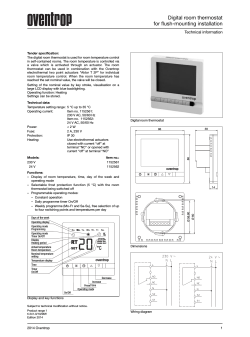
Wiring Diagram/Operation - Emerson Climate Technologies
INTEGRATED FURNACE CONTROLS 21M51U-843 WIRING AND CONFIGURATION 50M51-843 TYPICAL WIRING DIAGRAM HOT (LINE) NEUTRAL (LINE) 120 VAC 24 VAC CLASS II TRANSFORMER TH 24 VAC TR 50M51-843 COOL PARK HEAT LO HEAT HI CIRCULATOR BLOWER LINE XFMR EAC HUM INDUCER HUMIDIFIER (OPTIONAL) R R G G W2 W2 W1 W1 Y2 Y Y1 YLO (Trane application) Twin Application Only TWIN C HLO HLI FP PS1 MVL MVH GND GND PS2 MV COM TR TH FLAME SENSOR PROBE (Lennox only) 50M51-843 in other furnace HIGH LIMIT ROLLOUT (N. C.) SWITCH (N. C.) 1ST STAGE PRESSURE SWITCH (N. O.) AUX. HIGH LIMIT (N. C.) GAS VALVE 2ND STAGE PRESSURE SWITCH (N. O.) FP2 www.white-rodgers.com TECHNICAL HELP COMPRESSING UNITS IGNITOR CIRC N LINE N XFMR N HUM N EAC N ELECTRONIC AIR CLEANER (OPTIONAL) THERMOSTAT IGN IND HI IND LO IND N IGN N LEGEND Low Voltage (24 VAC) Line Voltage (120 VAC) N. C. = Normally closed switch N. O. = Normally open switch 179 21M51U-843 DIAGNOSTIC TABLE INTEGRATED FURNACE CONTROLS DIAGNOSTIC TABLE Green LED Flash Amber LED Red LED Flash Flash Error/Condition 1 Flame sensed when no flame should be present 2 Pressure switch stuck closed/ inducer error Pressure switch stuck closed. Check switch function, verify inducer is turning off. 3 1st-stage pressure switch stuck open/inducer error Check pressure switch function and tubing. Verify inducer is turning on the pulling sufficient vacuum to engage switch. 4 Open limit switch Verify continuity through rollout switch circuit. 5 6 Open rollout/open fuse detect 1st-stage pressure switch cycle lockout Verify continuity through rollout switch circuit, check fuse. if the first stage pressure switch cycles 5 times (open, closed) during one call for heat from the thermostat the control will lockout. Check pressure switch for fluttering, inconsistent closure or poor vacuum pressure. 7 External lockout (retries) Failure to sense flame is often caused by carbon deposits on the flame sensor, a disconnected or shorted flame sensor lead or a poorly grounded furnace. Carbon deposits can be cleaned with emery cloth. Verify sensor is not contacting the burner and is located in a good position to sense flame. Check sensor lead for shorting and verify furnace is grounded properly. 8 External lockout (ignition recycles exceeded where flame is established and then lost) Grounding or Reversed polarity Check items for exceeded retries listed above and verify valve is not dropping out allowing flame to be established and then lost. Verify the control and furnace are properly grounded. Check and reverse polarity (primary) if incorrect. Verify valve is not receiving voltage from a short. If a valve wiring is correct and condition persists, replace module. 9 1 2 1 10 Module gas valve contacts energized with no call for heat 11 Limit switch open – possible blower failure overheating limit Module Ignitor contact failure Possible blower failure, restricted air flow through appliance or duct work. Verify continuity through limit switch circuit and correct overheating cause. 12 Fault code indicates the module ignitor contacts are not functioning properly. Replace module. Solid Module - internal fault condition Module contacts for gas valve not operating or processor fault. Reset control. if condition persists replace module. Rapid Twinning error Check wire connections. If condition persists, replace module. 3 double 2nd-stage Pressure Switch Stuck Open/Inducer Check pressure switch function and tubing. Verify inducer is turning on and Error pulling sufficient vacuum to engage switch. Normal Operation with call for first stage heat Normal operation - first stage Normal Operation with call for second stage heat Normal operation - first stage 3 W2 present with no W1 4 Y present with no G call Rapid Low flame sense current Second stage call for heat on thermostat circuit with no call for first stage. Verify dip switches are set for two stage thermostat and check thermostat first stage circuit. Configured for a multi-stage thermostat the Module will not initiate heating unless first stage call from thermostat is received. Module will allow cooling to operate with only a "Y signal from the thermostat but will also trigger this code. Verify thermostat is energizing both "Y" and "G" on call for cool. Check "G" terminal connections. Low flame sense current is often caused by carbon deposits on the flame sensor, a poorly grounded furnace or a mis-aligned flame sense probe. Carbon deposits can be cleaned with emery cloth. Check for improve furnace and module ground. Verify sensor is located in or very near flame as specified by the appliance manufacturer. Normal operation. Waiting for call from thermostat or receiving thermostat call for cool. Standby or Call for Cool LAST FAULT MODE TECHNICAL HELP Comments/Troubleshooting Verify the gas valve is operating and shutting down properly. Flame in burner assemble should extinguish promptly at the end of the cycle. Check orifices and gas pressure. To retrieve fault codes, push and release the "LAST ERROR" button for more than 1/5 second and less than 5 seconds. (Control will indicate this period by solid GREEN for 1/5 to 5 seconds). The LED will flash up to five stored fault codes, beginning with the most recent. If there are no fault codes in memory, the LED will flash two green flashes. The control will flash the most recent error first and the oldest error last (last in first out). There shall be 2 seconds between codes. Solid LED error codes will not be displayed. DIAGNOSTIC FEATURES The 50M51 control continuously monitors its own operation and the operation of the system. If a failure occurs, the red LED on the control will flash a failure code. If the failure is internal to the control, the light will stay on. In this case, the entire control should be replaced, as the control is not field-repairable. If the sensed failure is in the system (external to control), the LED will flash in the following flash-pause sequences to indicate failure status (each flash will last approximately 0.25 seconds, and each pause will last approximately 2 seconds.) During a second-stage error condition, the red LED when in lockout will flash groups of double pulses. The red LED will flash on for approximately 1/15 second then off for 1/15 second then on for 1/15 second, then off for 3/10 second. The pause between groups of flashes is approximately 2 seconds. 180 www.white-rodgers.com
© Copyright 2025











